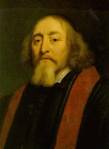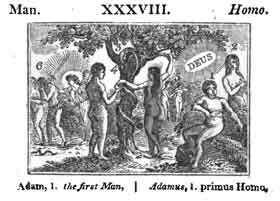John Amos Comenius
1592-1670

John Comenius, known today as the father of modern education, was a 17th century Czech (Moravian) educational reformer and religious leader. Among his educational contributions were three language-teaching books. The first of these was Janua linguarum reserata (The gate of tongues, unlocked), published in 1631. It contained short phrases about a topic with the phrases containing a number of terms related to the topic for the students to focus their attention on. The topic in the lesson illustrated below was the genesis story, and the related terms were Adam, Eve, serpent, forbidden tree, condemned, and paradise.

Adam, 1. the first Man,
as made by God
after his own Image,
the sixth day of the Creation,
from a lump of earth
And Eve 2.
the first woman
was made of the rib of man.
These being tempted
by the Devil
in the shape of a serpent, 3
when they had eaten
of the fruit of the forbidden tree, 4.
were condemned, 5.
to misery and death,
with all their posterity
and cast out of Paradise, 6.
In 1633, Comenius wrote an introduction to his earlier Janua linguarum called Januae linguarum reserata aureae vestibulum (Preface to the gate of tongues unlocked). This book, designed to teach children Latin, contained 500 questions with one word answers and served as an exercise book for the Janua linguarum reserata.
The third of Comenius’s books was a children’s picture book, among the first of its kind, called Orbis sensualium pictus or The world in pictures. It was published in 1658. Its purpose was to teach Latin to children by providing them with pictured vocabulary contextualized in sentences or small thematic informational expositions, describing something about religion or the world. There were 150 such expositions. The teacher was advised by Comenius to teach meanings and associated vocabulary in the following sequence: presentation-translation-repetition-and memorization.
Another book, published in 1649, and considered his most important, was Didactica magna (The great didactic). The book forwards a philosophy of teaching called pansophism (universal knowledge) whose aim it is to teach all things to all people from all points of view. Comenius believed that humankind through pansophic teachings could live in harmony. He presumed that children have a natural craving for knowledge and goodness. In Comenius’s words:
We venture to promise a Great Didactic ... the whole art of teaching all things to all men, and indeed of teaching them with certainty, so that the result cannot fail to follow… Lastly, we wish to prove all this a priori, that is to say, from the unalterable nature of the universal art of founding universal schools (Comenius, 1896, p.157).
In his educational programs, Comenius combined Christian tradition with 17th century scientific discoveries. In Pansophiae prodromus (1639) and Pansophiae diatyposis, he described his aim to teach in such a way that his students will have “a full adult comprehension of the divine order of things”. Comenius believed there was only one truth, one that emanated from God. His educational approach, the pansophic one, was to teach all things to all students and from all points of view.
Comenius recommended further that teaching be tailored to the level of the student. In his words: schooling should be “arranged to suit the capacity of the pupil, which increases naturally with study and age” (Comenius, 1896, p. 289). And he recommended that “the naturally dull and stupid” should also be educated. “The slower and the weaker the disposition of any man, the more he needs assistance.... Nor can any man be found whose intellect is so weak that it cannot be improved by culture’ (Comenius, 1896, p. 67).
Comenius saw schooling as developmentally based and divided into four stages. The first for infants was at the mothers breast. The second for children ages 6 to 12, was a public vernacular school in which teaching should be with and about the child’s first language. Children at the vernacular school would take different classes, including "religion, ethics, diction, reading, writing, math, music, economy, civics, history, geography, and handicraft" (Encyclopædia Britannica). Students from ages 13 to 18 would learn Latin, i.e. grammar. Courses involving language arts and the sciences would be focused on. And students between 19 and 24 would continue on to higher education at a university where they would live. At this level the students would learn through travel, as well as study at the school.
Comenius placed considerable importance on language at all levels of schooling. He recommended teaching all aspects of language, since good language skills are a basic prerequisite for intellectual improvement. Moreover, he felt that language education should equip young people with a deep knowledge of the Bible and a sense of their own religious duties and obligations.
Besides the picture-word context-based method, Comenius promoted a conversational approach to language learning and recommended that teaching be done in the student’s vernacular rather than in Latin.
In The great didactic Comenius recommended learning from nature, outside school contexts. If a child is in a school, he argued that learning should extend beyond the classroom and take place in everyday life. He accomplished this acquisition of worldly knowledge by giving students contact with objects in the environment and systematizing knowledge to make it more accessible and relevant to the children’s interests and life needs.
Among the methods promoted by Comenius is that involving learning by doing—something that was to later become associated with John Dewey and the progressive education movement in America in the 1930s.
Craftsmen do not hold their apprentices down to theories; they put them, to work without delay so that they may learn to forge metal by forging, to carve by carving, to paint by painting, to leap by leaping. Therefore in schools let the pupils learn to write by writing, to speak by speaking, to sing by singing, to reason by reasoning, etc., so that schools may simply be workshops in which work is done eagerly.
Comenius’s program was a progressive one. He advocated for educational opportunities for women and argued against the use corporal punishment except in cases of “moral perversity.”
Comenius’s educational program is built upon a set of principles, many of which are based on how teaching methods should follow the rules of nature:
Cominius’s Teaching Principles (in his own words)
Following in the footsteps of nature we find that the process of education will be easy:
- If it begin early, before the mind is corrupted.
- If the mind be duly prepared to receive it.
- If it proceed from the general to the particular. ,
- And from what is easy to what is more difficult.
- If the pupil be not overburdened by too many subjects.
- And if progress be slow in every case.
- If the intellect be forced to nothing to which its natural bent does not incline it, in accordance with its age and with the right method.
- If everything be taught through the medium of the senses.
- And if the use of everything taught be continually kept in view.
- If everything be taught according to one and the same method.
These, I say, are the principles to be adopted if education is to be easy and pleasant (Cominius, 1628/1896, Chapter 17, p. 127).
Writings by John Comenius
Didactica magna (The great didactic) (1628-32; tr. by M. W. Keatinge, 1896; 2d ed., Pt. I, 1910, Pt. II, 1923, repr. 1967) Contains an exposition of his educational principles. Retrieved on May 27, 2010
http://core.roehampton.ac.uk/digital/froarc/comgre/
Janua linguarum reserata (1631; tr. The Gate of Tongues Unlocked, 1659)
Labrynth of the world and paradise of the heart. Retrieved on May 27, 2010 from http://users.ox.ac.uk/~tayl0010/labyrint/labyrinth_frame.html
Orbis sensualium pictus (1658; tr. The Visible World, 1659).
http://www.archive.org/stream/orbispictusofjoh00comeiala#page/4/mode/2up
Writings about John Comenius
Keatinge, M. W. (2005). The historical life of John Amos Comenius. Kessinger Publishing.
Keatinge, M. W. (2005). A critical examination of the life of John Amos Comenius. Kessinger Publishing.
Laurie, S. S. (1885/1973). John Amos Comenius: His life and educational work. Boston: Willard Small.
Monroe, W. S. (1900/1971). Comenius and the beginnings of educational reform. NY: Charles Scribner’s Sons.
Murphy, Daniel (1995). Comenius: A critical reassessment of his life and work. Dublin: Irish Academic Press.
Piaget, J. (1999). John Amos Comenius. Retrieved on May 28, 2010 from
Sadler, John (1966). J. A. Comenius and the concept of universal education. NY: Barnes and Noble.
